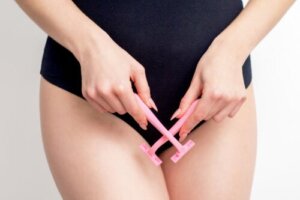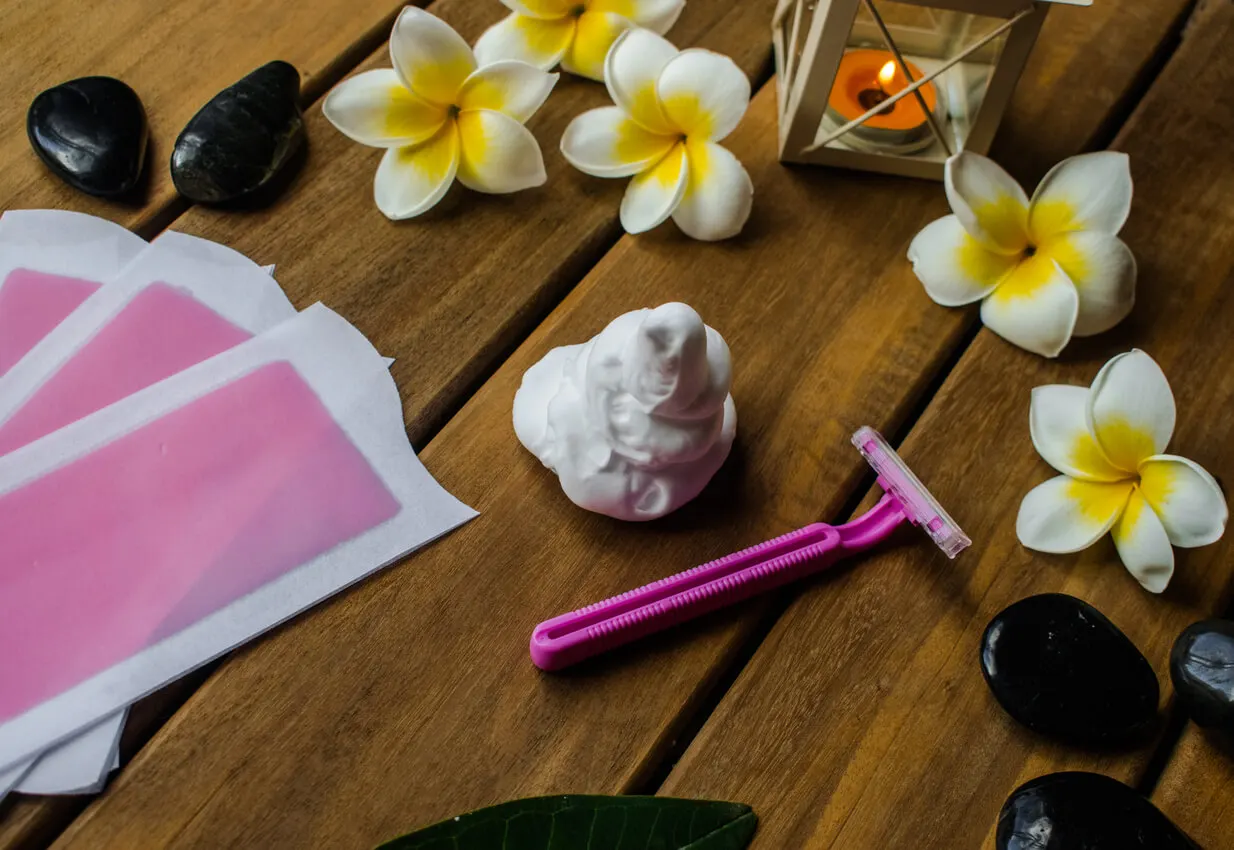3 Methods for Intimate Area Hair Removal

There are several methods for intimate area hair removal, and it’s best for each person to choose the one that best suits what they’re looking for. In general, the process shouldn’t be too painful or cause irritation or other problems.
In fact, as far as possible, there should never be complete hair removal should, because the hair in this area serves as a protective barrier. Therefore, lacking pubic hair completely increases a person’s risk of infections or other vaginal diseases.
It’s also a fact that waxing this area is a bit more complex. The procedure can be uncomfortable and sometimes leaves unpleasant consequences. Therefore, it’s a good idea to know the different options and how to apply them properly.
Intimate area hair removal
One of the factors that make hair removal of the intimate area complicated is that the skin in this area is more sensitive than in other parts of the body. Therefore, it’s not uncommon for hair removal to cause irritation, allergies, or itching.
Added to this is the fact that there are several myths about it. Some people think that the absence of hair is synonymous with cleanliness and neatness when this isn’t really the case. As we already mentioned, in the case of women, these hairs act as protectors.
Incorrect hair removal can cause very annoying problems, such as ingrown hairs. This occurs when the hair fails to grow outward and then inward, resulting in a cyst.
In any case, each method of hair removal in the intimate area has its advantages and disadvantages. The most usual are three: with wax, with cream, or with a shaver. We’ll will talk about each of them below.

1. Waxing the intimate area
Hair removal of the intimate area can be done with hot or cold wax. This is the most popular method, as it allows the hair to be pulled out by the root. Thanks to this, the effect can be maintained for up to four weeks.
On the other hand, this method can be painful and can even cause irritation on certain types of skin. In the case of both hot and cold waxing, it’s best to exfoliate three days beforehand to remove dead cells and prevent ingrown hairs.
Hot waxing
Before applying this method, it’s important to keep the pubic area clean and dry. The wax should be heated, taking care that it doesn’t reach such a high temperature that it ends up burning the skin. It shouldn’t be too cold either, because it will generate more pain this way.
Once the wax is melted, it should be spread gently on the skin. It’s important to use a mirror to keep an eye on the whole process. The product should be placed in the same direction in which the hair grows. Afterward, let it cool for a few minutes and remove it by pulling it in the opposite direction.
The remaining wax should not be reused to prevent infections. At the end of the process, moisturizing cream should be applied and sun exposure of the waxed area should be avoided for the next 24 hours.
Like this article? You may also like to read: Intense Pulsed Light Hair Removal: Everything You Need to Know
Waxing with cold wax
This method is more painful, but it also guarantees the effects for longer. Cold waxing is most effective when the hairs are short. It should be done from the outside in and from the top down. The steps are as follows:
- Place the cold wax strip in the same direction in which the hair grows.
- Tighten the skin above the strip.
- Pull the strip vigorously in the opposite direction of hair growth. This shouldn’t be done little by little, but all at once.
- Repeat until all the hair is removed.
- Apply moisturizing cream.
2. Intimate area hair removal: Hair removal cream
Another method for hair removal in the intimate area is the use of depilatory cream. It’s the option that generates less pain, so it’s indicated for people with very sensitive skin. However, the effects will only last a couple of days.
In short, it’s the fastest and least aggressive method, but also the one that lasts the shortest. It’s best to do a test before using this type of cream.
It’s only necessary to apply a little on the forearm and wait 24 hours to verify that there is no reaction. The correct way to perform the procedure is as follows:
- Clean the area with soap and water to remove impurities. Dry it thoroughly.
- Trim the hairs so that they’re no longer than half a centimeter to facilitate hair removal.
- Apply the cream to the chosen area. The film should be thin, but in sufficient quantity to cover the base of the hair.
- Wait a few minutes for the product to act, following the product instructions.
- Rinse thoroughly until the product is completely removed.
- Apply moisturizing cream to avoid irritation.
3. Shaver
Shaving the intimate area with a shaver is also very common. It has advantages and disadvantages similar to those of depilatory cream. On the one hand, it’s a practical and painless method. On the other hand, its results are very short-lived.
Also, there is a risk of cuts or wounds during the process in this case. A manual or an electric shaver can be used. Let’s look at the characteristics of each of them.
Manual shavers
As in the other cases, the best thing to do is to wash the area with soap and water and then dry it very well. The rest only requires a few simple actions:
- Apply shaving gel or cream to the pubic area. This is essential to avoid irritation and prevent accidents.
- Pass the razor over the area to be shaved in the same direction as the hair growth.
- Moisturize continuously. Every time you pass the razor on your skin, pour water over the area. Ideally, this should be done in the shower.
- Apply a moisturizer at the end.
Intimate area hair removal: Electric shaver
This type of machine removes the hairs by the root, one by one. They do it through a tweezers roller. Therefore, it could be one of the most painful methods. On the other hand, it offers very good and long-lasting results.
The procedure with this method of hair removal in the intimate area is as follows:
- Exfoliate the area a day in advance. This helps prevent ingrown hairs.
- Before shaving, bathe the area with warm water. This opens the pores and makes the procedure easier.
- Stretch the skin with one hand and, with the other, pass the machine in the opposite direction of hair growth.
- Repeat, if necessary, until the hair is completely removed.
- Use moisturizer at the end.

Intimate area hair removal: Other tips and recommendations
It’s best to trim the hair with scissors before performing intimate area hair removal, except if you’re going to use an electric shaver. In this case, the hair should be at least 3 millimeters long so that the procedure can be performed properly.
If wax or creams are used, it’s very important to prevent these substances from coming into contact with the labia minora or vaginal mucosa. If you opt for manual shaving, you should use a new, good-quality razor, preferably specifically for intimate areas.
The electric shaver has the advantage that the hair loses its strength after some time of use and becomes less and less thick. The opposite can happen with manual shaving. The most advisable thing to do – in all methods – is to moisturize the skin at the end. You can do this with an aloe vera-based product, for example.
You may also find this article interesting: Is it Bad to Shave or Remove Pubic Hair?
Final recommendations
There are other methods for hair removal of the intimate area that practically guarantee hair removal in that area. Specifically, we’re referring to options like laser hair removal. However, we must consider the fact that in the case of women, permanent hair removal is not advisable.
Men can also use the methods described above without any problem. For hair removal of the testicles, it’s recommended to first trim the hair and then use a manual shaver or depilatory cream.
All cited sources were thoroughly reviewed by our team to ensure their quality, reliability, currency, and validity. The bibliography of this article was considered reliable and of academic or scientific accuracy.
- De La Hoz, F. J. E. (2021). Influencia de la depilación íntima en la aparición de infecciones vulvovaginales y urinarias. Estudio de corte transversal. Revista de la Asociación Colombiana de Dermatología y Cirugía Dermatológica, 29(3), 187-195.
- Martínez Navarro, M. (2018). Diseño de la formulación y del proceso de fabricación de bandas depilatorias con certificado ECOCERT.
- Romero-Gamboa, D. G., Díaz-Martínez, L. A., Díaz-Galvis, M. L., & González-Blanco, D. P. (2019). Impacto de la depilación genital en el microambiente de la piel femenina: interrupción de la barrera y riesgo de infección, una revisión de la literatura.
This text is provided for informational purposes only and does not replace consultation with a professional. If in doubt, consult your specialist.








